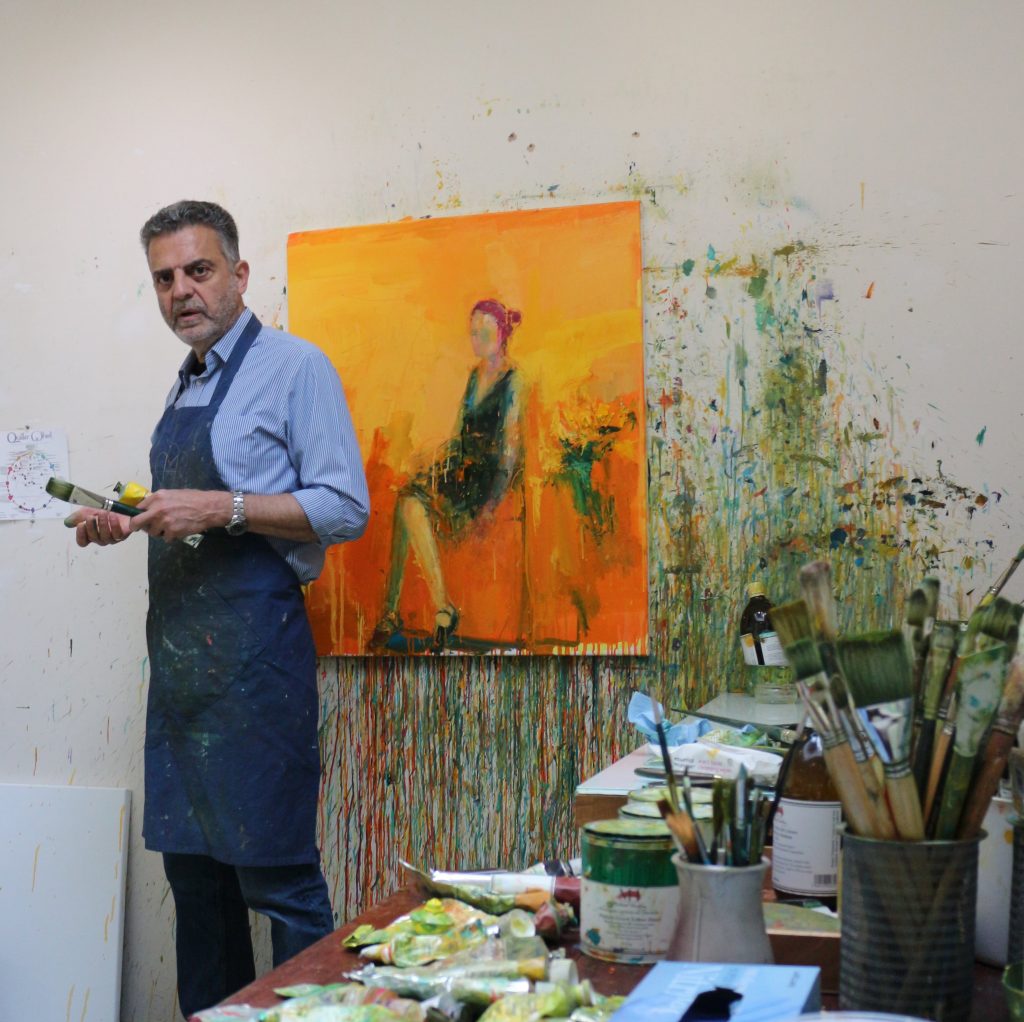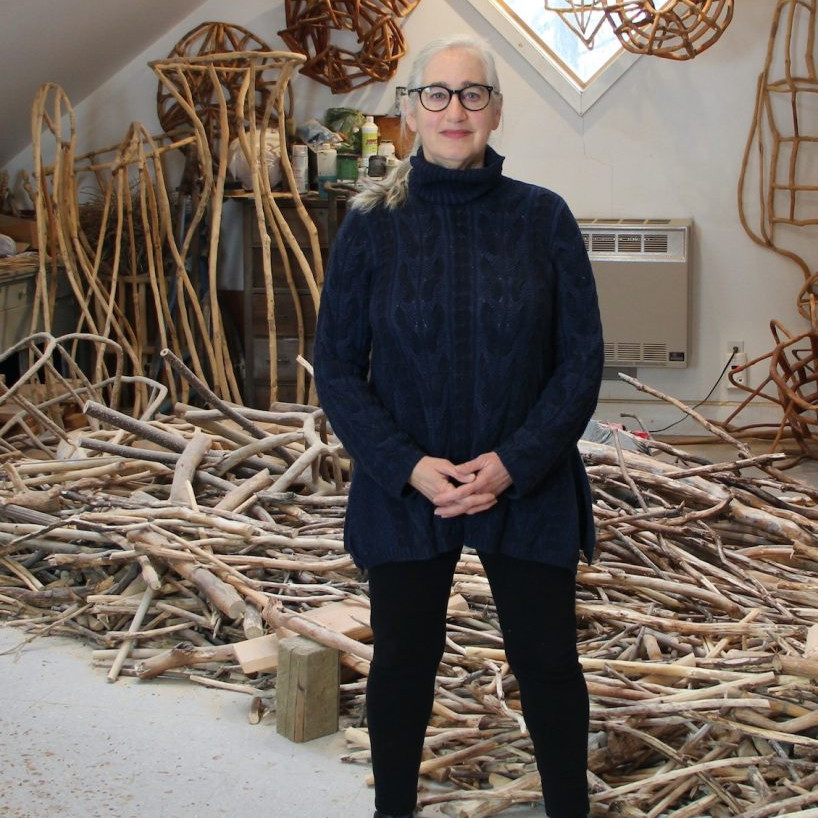Henry Jabbour Painter
You use colour and very heavy brush strokes; how do you still capture such serenity?
That is such an interesting question. I definitely don’t feel serene when I am painting. I am in constant struggle with paint, colour, form, my feelings and the feelings I get from what is on the canvas. Each painting is an emotional journey unique to itself. It is difficult for me to pinpoint how I achieve what I am after, but it does not happen on the spot. I have to live with the work and not look at it for some time so that when I come back to the canvas and work on it again, I am in a different emotional space. When I do that several times, then the angst initially felt and projected onto the canvas is diminished. I am glad you feel serenity in the work – I am always amazed and delighted by the diversity of emotions that my work evokes in the viewers.
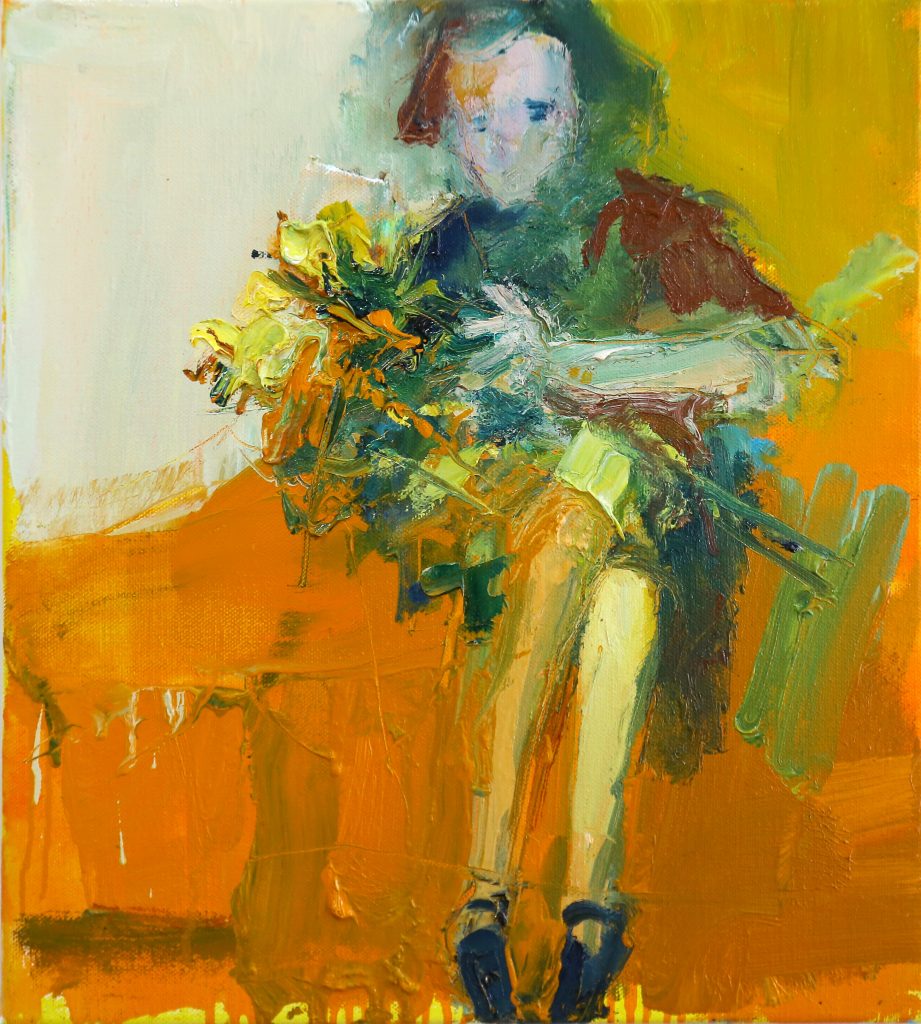
Lap of Roses, Oil on linen, 50 x 45 cms
Recently you have introduced the diptych format to your portfolio. How did this come about? Please give two images to explain this?
This happened organically – I don’t remember thinking “I want to do diptychs”. I was in my studio working on multiple canvases for my solo show ‘A Life More Human’ at The Union Gallery. The first diptych that emerged for this exhibition was ‘Your Heart to Mine – Eve and Adam’. I was painting the two canvases at the time but as two separate paintings, and at some stage they were placed next to each other against the wall. I felt there was a connection between the two figures – that they somehow were communicating and looking for each other. So I decided to unite them and started to paint them together. Every time I was painting on one, the other half was hanging next to it. So in this instance it was the work itself that demanded to be in diptych format, it somehow emanated that feeling of togetherness and belonging.
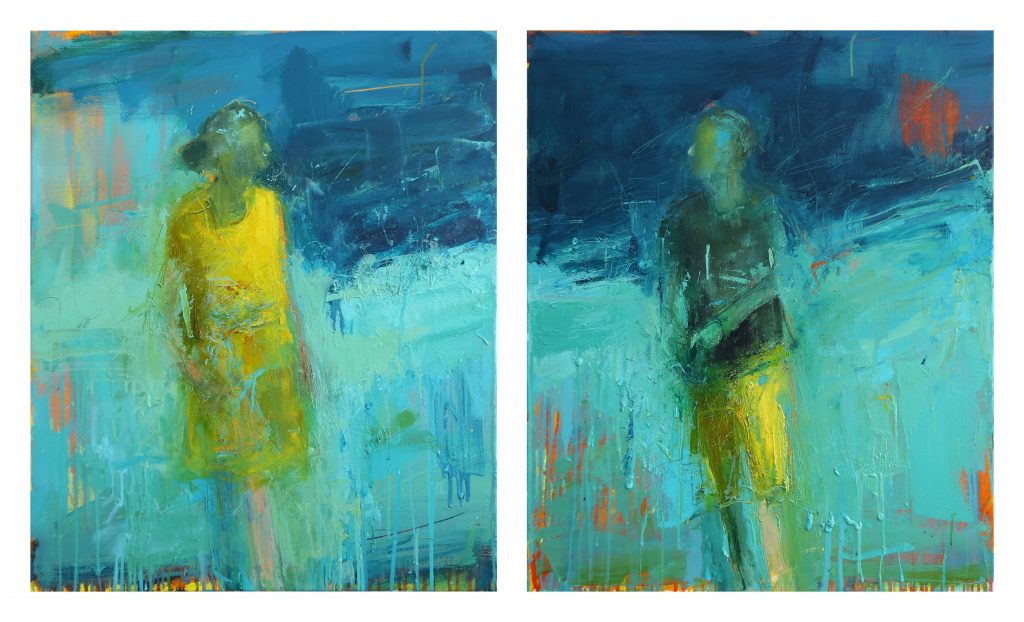
Your Heart to mine – Eve and Adam, Oil on Linen, 80 x 130 (80 x 65 cms)
What makes you stop at two?
The diptych in a way resembles duality for me. Many things are described in context of duality – light/dark, life/death etc… As I was exploring the diptych format in my work I was conscious of the passage “On Joy and Sorrow” by the Lebanese writer Gibran Khalil Gibran – He says: “When you are joyous, look deep into your heart and you shall find it is only that which has given you sorrow that is giving you joy”. Put simply – there is no joy without the experience of sorrow.
There is no reason to stop at two but in the context of this exhibition, the duality seemed important for me. ‘A Life More Human’ is about exploring the idea of being human and trying to portray that in a visual form. It is about being in the present moment independent of its duality with the past or the future. I remember years ago reading the philosopher Krishnamurti’s thoughts about fear – he says “Fear is never an actuality; it is either before or after the active present.” This resonated with me.
If I am ever to expand beyond the format of the diptych I feel there has to be an inherent reason for it – somehow it has to make sense within the work.
Do you feel that you need to keep these to a certain size and are they always sold together?
The size of the diptych again is dictated by the subject matter and the feeling that I am trying to bring to the viewer about the work. It is what feels intuitively right. The two canvases of the diptych do belong together. They are one work really, and I would not want them to ever be separated.
Can you discuss the connection between the elements of the diptych ‘My Heart Broke Loose’ III? And how does this relate to other paintings in the series titled ‘My Heart Broke Loose’?
The ‘My Heart Broke Loose’ series is about the symbolism we associate with flowers and our relationship with them. Flowers are inherently beautiful yet their beauty is transient, which is itself symbolic of the human condition, youth, ageing and death.
‘My Heart Broke Loose’ III is a dark painting compared to others in the series. The flowers are completely separated from the figure by the gap between the two canvases. I don’t want to place a particular interpretation on it, but it could be a momento mori or a depiction of grief.

My Heart Broke Loose III, Oil on Linen, 30 x 30 (30 x 60 cms)
The earlier paintings in the series do not have the same sense of separation between the figure and the flowers. In the first such painting, ‘My Heart Broke Loose’ for example, the flowers spill across both canvases so that the figure is immersed and surrounded by them. This painting is lighter and more joyful, a feeling I have tried to express through composition and colour.
Flowers are an integral part of your work — discuss.
My studio in Cambridge is at the bottom end of my garden which was designed with the idea of having blooms for a considerable part of the year and with a variety of colours. So as I walked to my studio every morning I would see these blooms and colours and eventually they somehow worked their way into my canvases. Again, the flowers have a particular significance in the work for me. Our relationship with flowers is really intriguing and complex – we marvel at their beauty and they delight us. We offer them to others at times of great joy and at times of great sorrow. Their beauty is very transient – and somehow they remind us of the cycle of life and death, vigour and disintegration, youth and old age. Observing and appreciating the beauty and life cycle of flowers is about being human and being in the moment.
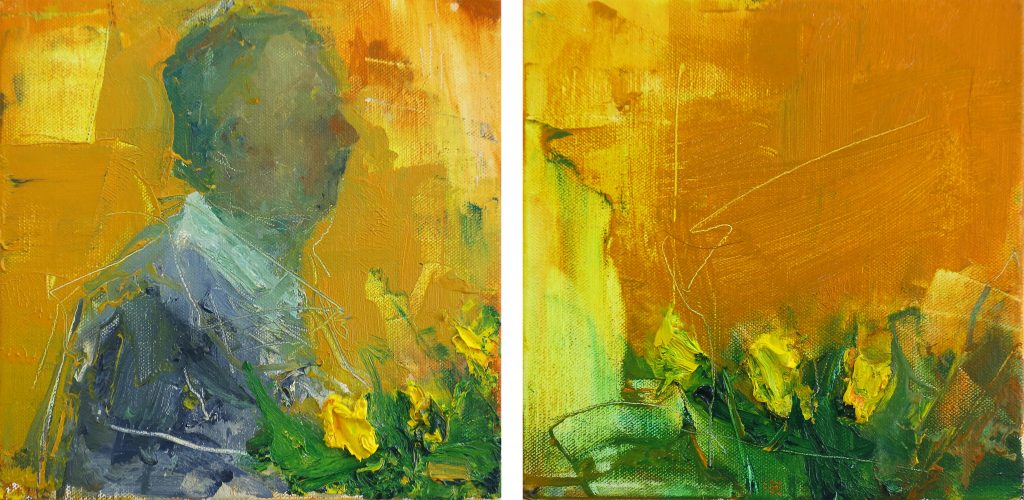
My Heart Broke Loose, Oil on Linen, 30 x 30 (30 x 60 cms)
Flowers aren’t always associated with women in your work; discuss using ‘Man Amongst His Roses’.
Absolutely – for some reason, society’s relationship or perception of flowers is often associated with the feminine. It is not a masculine thing to say, I love flowers. Traditionally, you would not give a male friend or partner a bouquet of flowers (although thankfully these stereotypes are fading). I wanted to challenge this in my work. I wanted the love of flowers in my work to be gender neutral.
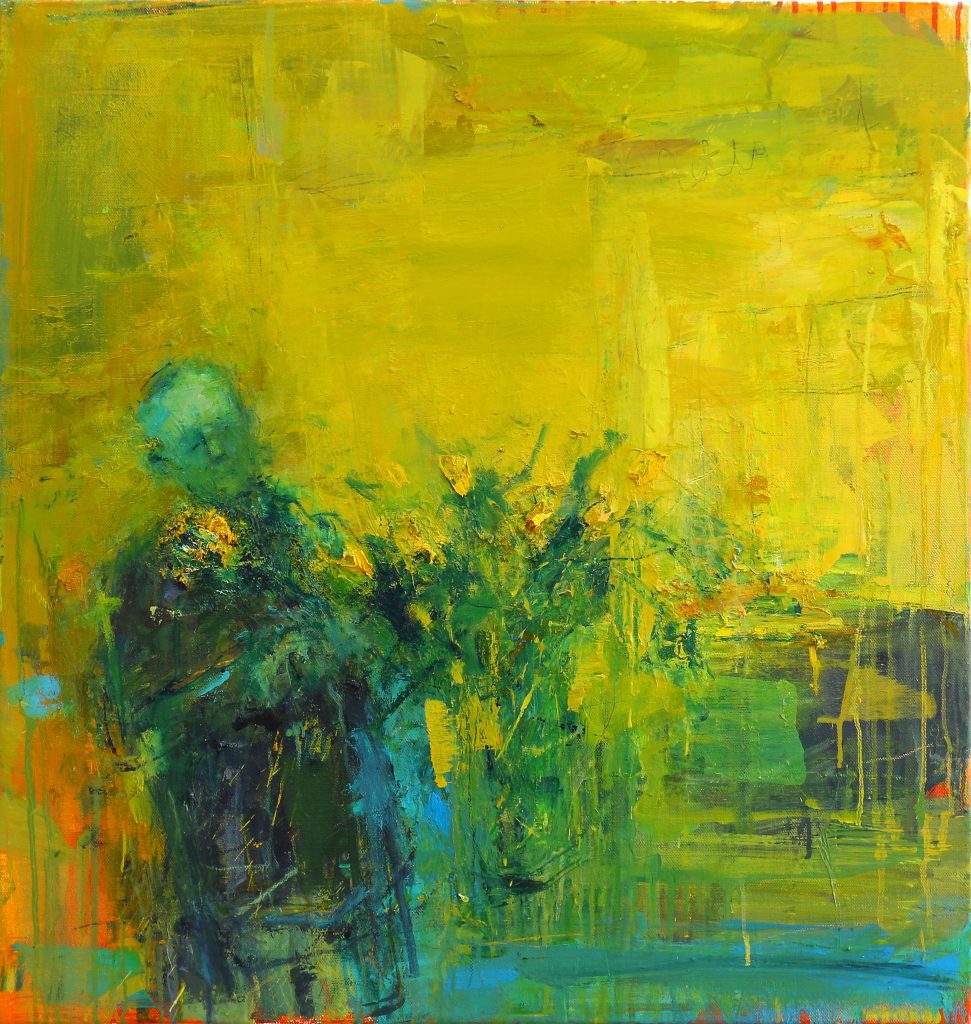
Man Amongst the Roses, Oil on Linen, 81 x 75 cms
How has your training as an artist affected your work? And how has this developed over time?
I have had a traditional training – I learnt to draw and paint using traditional methods of observation. That was important to me – I sought that knowledge. However, over time my work has really diverged from it. Although I still draw from observation, when I paint I rely mostly on memory and imagination. My colours are mostly imagined or remembered from past experiences. However, I think I would not have been able to explore this way of working if I did not have a good understanding of the anatomy of the human body, the fall of light on an object, and traditional theories of colour. All these were provided by my years of formal training in art.
How do you manage combining painting, printmaking, and sculpture into your time frame?
Bringing my ideas to life using different media is very exciting for me. They somehow connect on many levels – intellectually, emotionally and technically. I do not see them as separate bodies of work. The way I paint sometimes changes after I come back from a week of printmaking. I have been painting and printmaking for some time now, but sculpture is a new venture. I remember being in Galerie Alice Mogabgab in Beirut which represents my work and seeing the sculptures of Emma Rodgers (a renowned British sculptor). I immediately fell in love with her work. I contacted her when I was back in the UK and she invited me to visit her studio. Emma’s work had a profound impact on me. We are exploring similar ideas in our art. Emma thought that my work could be translated into sculpture so she invited me to come and work with her in her studio to explore the possibility. That was very exciting for me. I did that over a period of two and half years and created some of the sculptures that are in this exhibition.
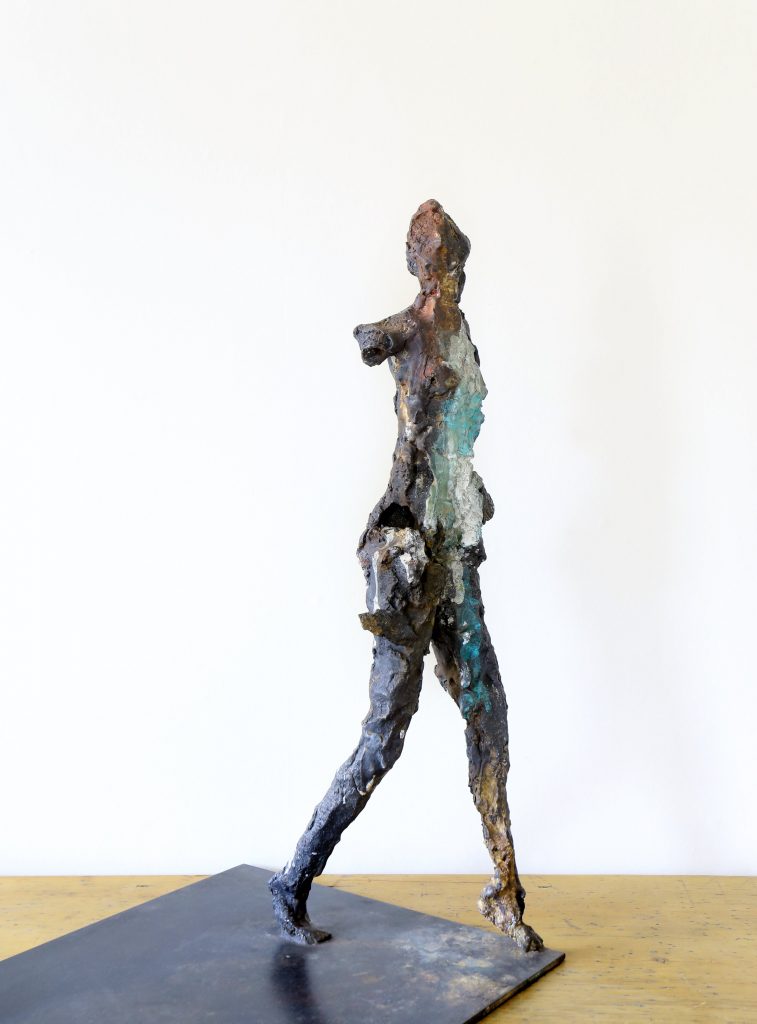
Stepping Out, Unique Bronze, L68 x W36 x H63 cms
In your current exhibition you have ‘When The Light Returns’, why was this the painting chosen for the impressive exhibition book?
The choice about which painting to use for the cover was made by Alison Auldjo (the director of The Union Gallery who is hosting my second solo show in Edinburgh). I wanted to leave it to her to make that choice. I think she chose that because it was the last painting I made for this exhibition. The more I think about it the more I feel it was such a good and inspired choice. ‘When The Light Returns’ is a very optimistic painting and a very optimistic title – ‘A Life More Human’ ought to be about optimism and joy as well as darker feelings too.
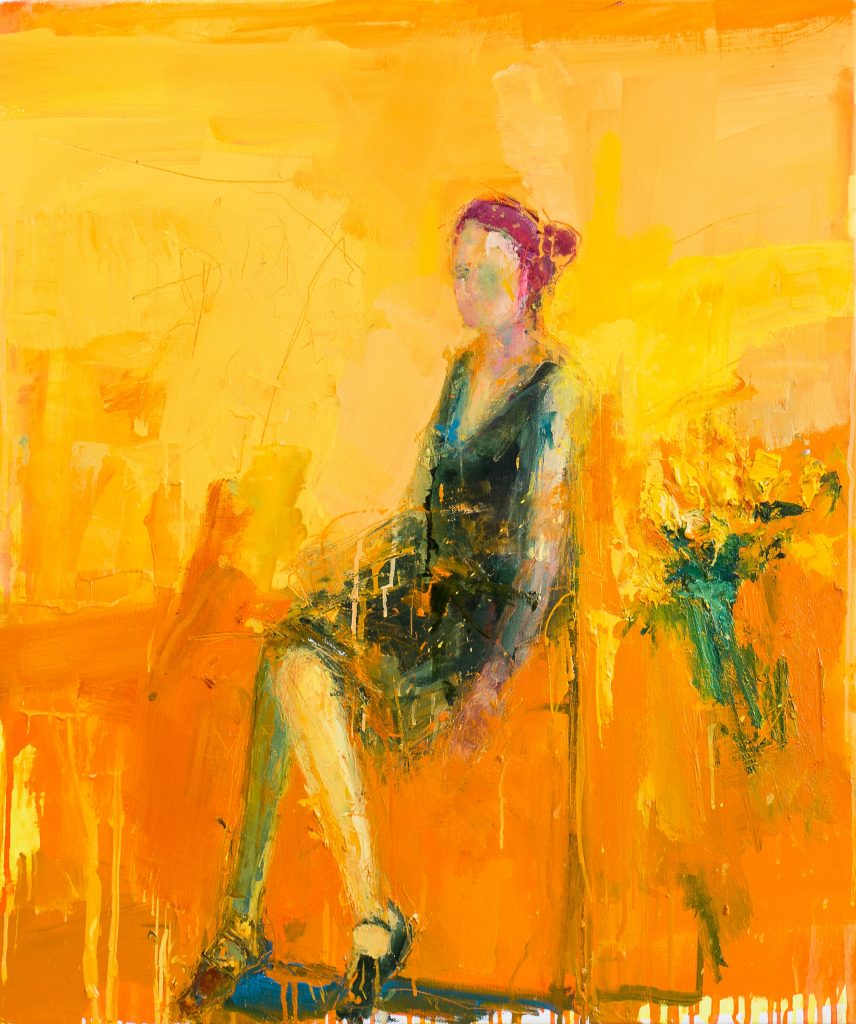
When the Light Returns, Oil on Linen, 96 x 81 cms
When I was working on this painting I wanted to explore the joy I get from light. Being bathed in sun, feeling its warmth on the skin and the tranquility that one can get from it. The woman is just sitting there — feeling the moment. That is what I wanted for that painting and that is the first impression that I want the viewer to get from that work. After that, I want the viewer to further their experience of the work by exploring all the other components in it and for them to build their own story with it.
With the painting ‘Morning Ritual’…Discuss beyond the obvious tea ritual to the deeper ritual of craft. (You may like to add ‘Threading’ to this answer.)
The paintings ‘Morning Ritual IV’ and ‘Threading’ are really inspired by ‘Intimism” – an art movement of the late 19th and early 20th century that depicts the human figure in domestic scenes. Artists that championed ‘Intimism’ include Pierre Bonnard, Edgar Degas and Edouard Vuillard, and more recently Richard Diebenkorn. These are all artists whose work I really love and admire.
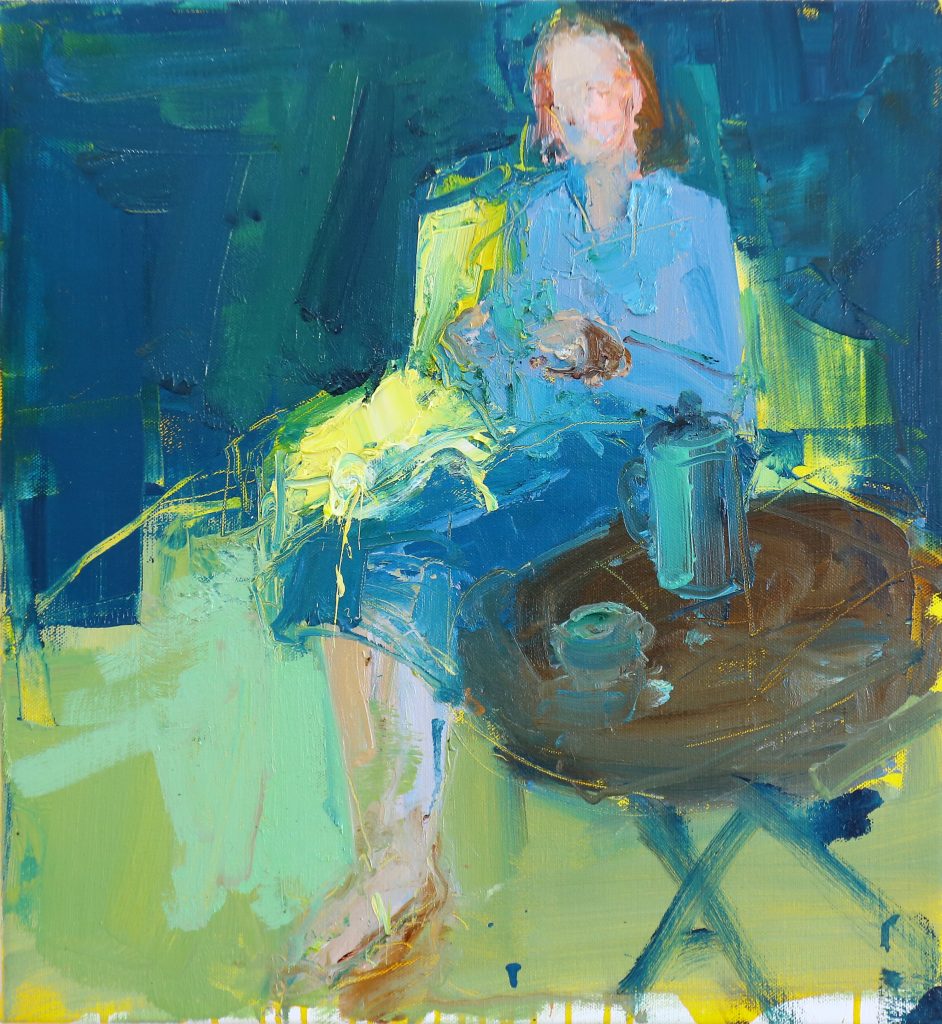
Morning Ritual, Oil on Linen, 60 x 65 cms
The two works you mention are a personal take on this idea. They are also about the human spirit being engaged with the moment and appreciating it. Morning Ritual is about the early morning rise with a cup of coffee, being at one with one’s thoughts and the world. Threading depicts the moment of concentration of threading a needle – such a simple task, but one which requires our whole attention.
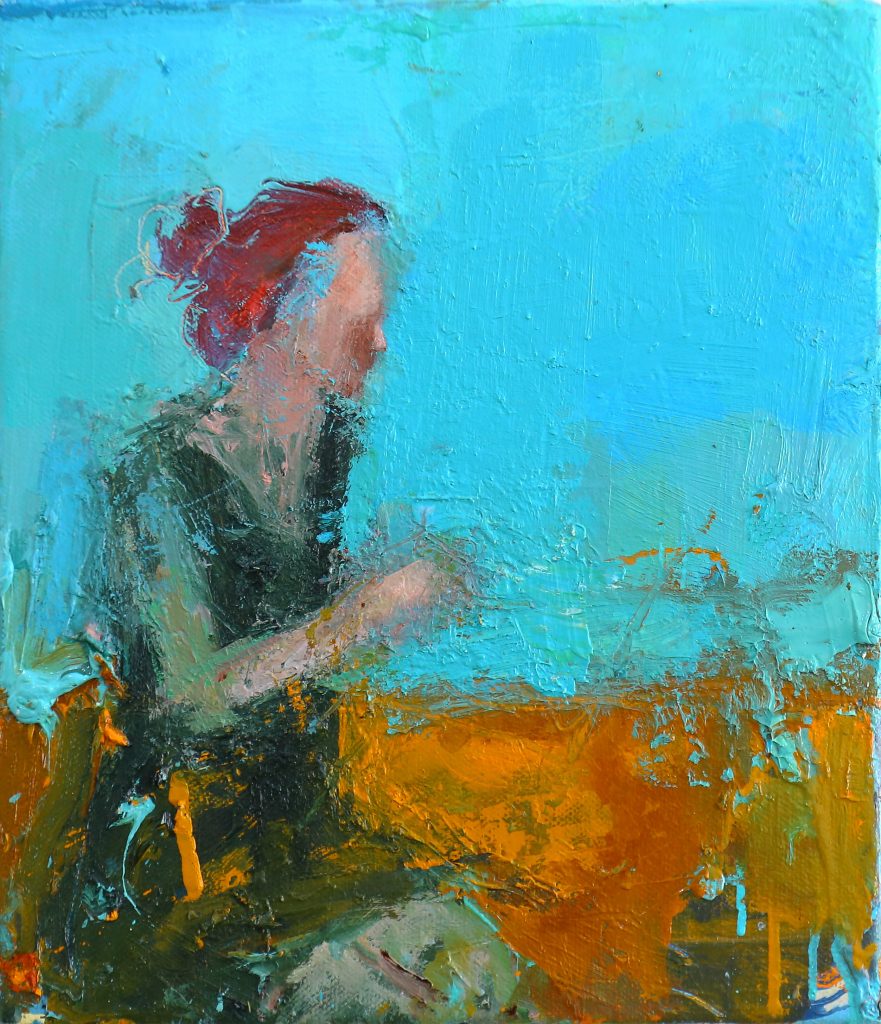
Threading, Oil on Linen, 35 x 30 cms
‘Seated Woman’ is seen as timeless elegance – discuss.
The figure in the painting is caught in a moment of reflection or relaxation. She is at ease with herself, and carries her body with ease, unlike some people who are elegant only when others are watching. The painting is about feeling at home in your own skin, being reflective, and not trying to be something you are not.
There is no pretension about her, she just is.
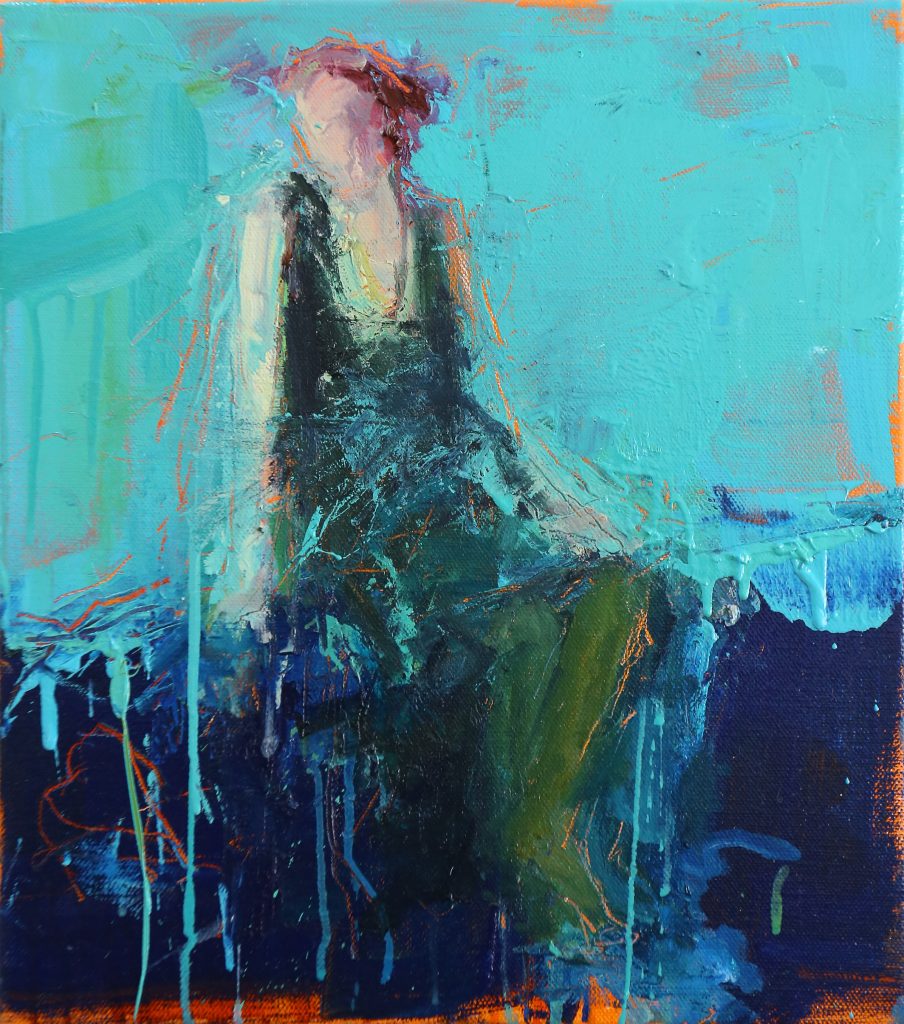
Seated Woman, Oil on Linen, 45 x 40 cms
‘Beauty Within’ discuss.
‘Beauty Within’ is a ceramic sculpture of a standing male figure. The figure hangs simply on the wall. He looks weathered and scarred but stands tall and proud.
This sculpture is about the experience of being human but he resists being labelled or being defined by his experiences or his scars. Despite the nail driven through his hips and the cracks in his body and limbs the Beauty of ‘Him’ shines through from within.
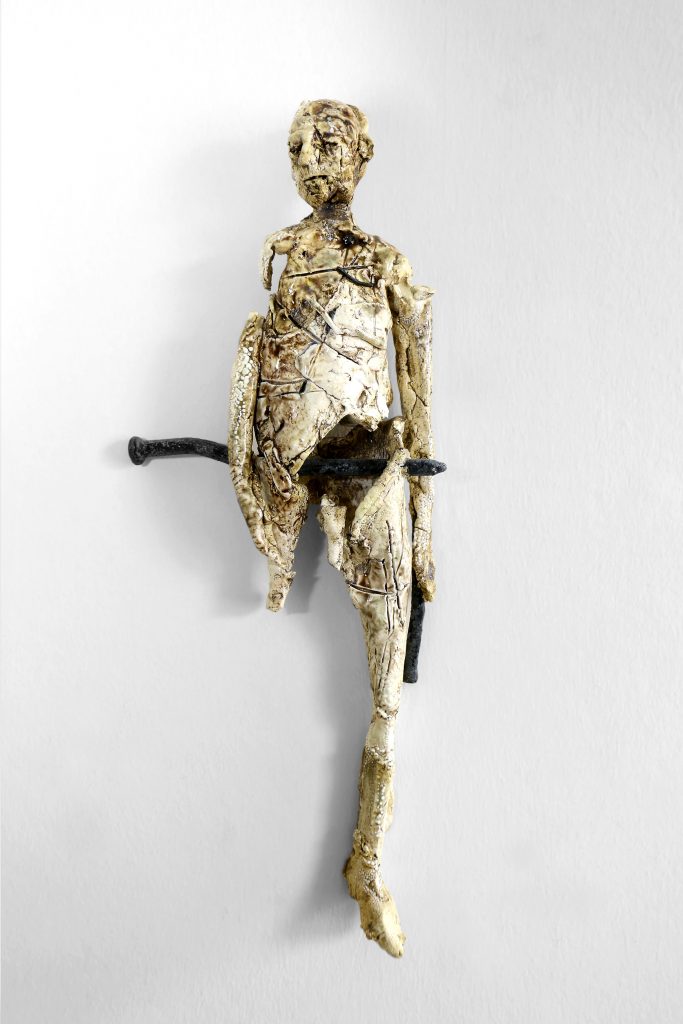
Beauty Within, Unique Ceramic Sculpture
He is the embodiment of the quote by the Spanish Writer José Saramago “Inside us there is something that has no name; that something is what we are”.
Expand on your method of two plate etching, use ‘Dancer III.
Etching is an exciting print process where an image is created on a plate (traditionally copper plate) by using strong acid. The process of etching dates back to the 15th century and there are many renowned artists who have created wonderful works using this technique, most notably Rembrandt, Dürer and William Blake. Over time, etching has been adapted and developed so that images can be produced more creatively. For me, etching is important in my practice because of its sense of history. I feel like I am connecting with past artists that I admire and that I am continuing in a rich tradition. I have created images using single and double plate etching techniques.
Two plate etching is when I am creating an image using more than one plate – so the final print is created by pressing the paper through the press sequentially against two individual copper plates loaded with different colour inks. This method allows me to add more than one colour to an image. For example, in ‘Dancer III’, the majority of the image in this etching was created on one plate – that being the dancer. In the second plate, I added the green turquoise colour in the foot and in the background. Adding a second colour to the image was important for me and it somehow helped my print work to have a dialogue with my paintings and sculpture.
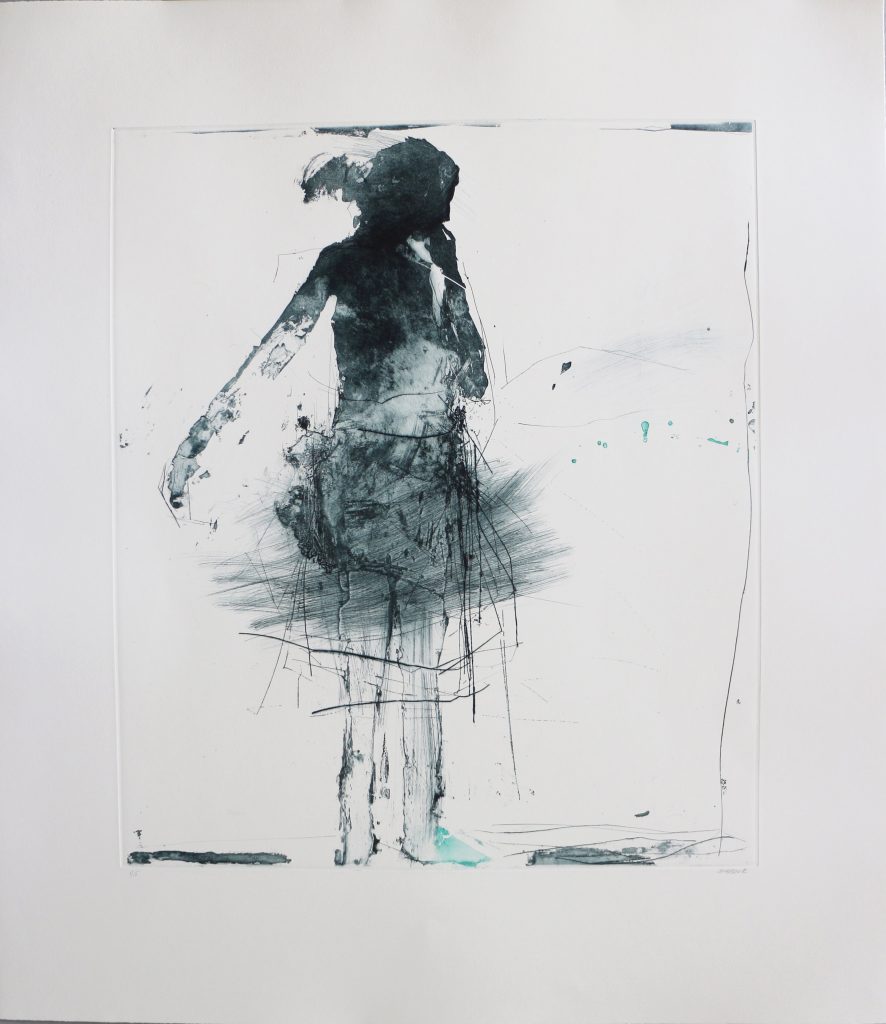
Dancer 111, Lift Ground Etching and aquatint from copper plates
Lastly expand on how you show emotion in your art.
This question is really hard to answer – it’s like having to explain where does emotion come from. I think I show emotion in my work because I feel emotion when I am working. All my work comes from an inner emotional place or reservoir that I don’t try to control or even understand. But when I am painting, I am always trying to connect or relate to something. Without that, the work really feels vacant and then I have to abandon it. I think, for me, emotion also comes from colour – I do have an emotional relationship with colour, because I always associate colours with memories and the emotions that connect with these memories.
I do want my work to be about emotion – I strive for it to be the narrative in my work, and the fact that you have asked me that question, Deborah, tells me that you have somehow connected with my work at an emotional level and not only at a visual or intellectual level. That gives me comfort and joy – that I am reaching the viewer’s emotional space and providing nourishment for what goes on there.
Contact:
Henry Jabbour
Deborah Blakeley, Melbourne, Australia
Interview by Deborah Blakeley, August 2019
CLICK HERE TO >> READ INTERVIEW OF HENRY JABBOUR FROM MARCH 2017
Think a colleague or friend could benefit from this interview?
Knowledge is one of the biggest assets in any business. So why not forward this on to your friends and colleagues so they too can start taking advantage of the insightful information the artist has given?
Other artists you may be interested in:


